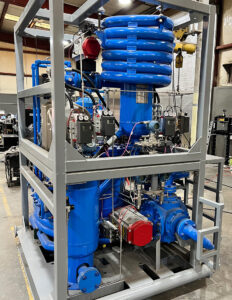Zero Emissions
Our technology eliminates emissions from the separation process. With Separa, producers can replace or augment heater treaters, vapor recovery towers and other sources of significant CO2 and methane.
For decades, separation has been carbon-intensive, imprecise and slow. Separator tanks may need up to 48 hours of retention time and require a large equipment footprint. Meanwhile, heater treaters and vapor recovery towers (VRTs) are major sources of emissions. Beyond these environmental and operational drawbacks, the current process also makes it nearly impossible to achieve accurate measurement. Separa’s products solve these challenges with an innovative approach that delivers immediate, zero emissions separation and accurate measurement.
Separa’s technology equips oil and gas producers to meet their sustainability goals, including urgent net zero targets.
From lower opex to less retention time, our innovative solutions makes environmental and economical sense.
Separa’s design enables real-time separation of two-phase flow. It utilizes three stages of flow restructuring and phase separation to completely force gas out of the liquid phase — with no retention time and no emissions.

Stage 1: Coil
Using centrifugal force, a coil pathway restructures fluid into a stratified smooth flow. A diverter valve directs all gas into the vessel.
Stage 2: Hydro-cyclones
Inside the vessel, hydro-cyclones forcibly remove the gas from the liquid to create the secondary phase separation.
Stage 3: Diverter plate
The diverter plate forcefully changes the direction and velocity of the liquid as it leaves the cyclone. This separates any remaining microbubbles from the liquid.
With separation complete, the single-phase gas and liquid exit different parts of the vessel, where it can be easily and precisely measured.
Learn more about the two-phase separation solution that helps producers reduce emissions and optimize measurement.
Explore Now
Separa’s three-phase separation system segregates production into a trio of single-phase streams. Equipped with multiple stages of production conditioning and separation, the approach eliminates retention time, emissions and imprecise measurement.
Learn more about the industry’s first real-time full-flow multiphase separation technology.
Explore NowDiscover our approach to the environment, safety and sound governance.
SustainabilityLearn more about the industry’s first real-time full-flow multiphase separation technology.
Explore Now